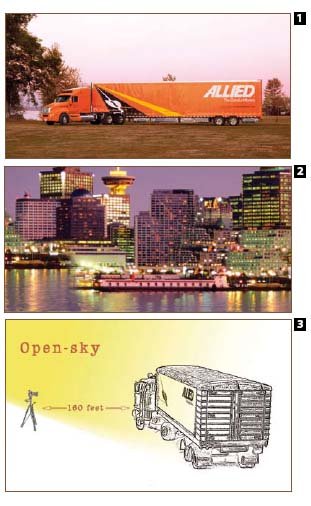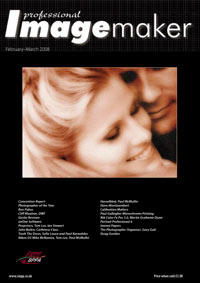articles/Lighting/thebiglight-page1
The Big Light - part 1 of 1 2
by Dave Montizambert Published 01/02/2008

Dave Montizambert joins in our feature on high-end gear
Receiving an assignment to light and photograph a gigantic, shiny object such as this 80-foot, orange, semi-trailer truck would put the fear of God into most us, but it need not if you employ the correct principles of lighting to the challenge.
This image, for Allied Movers/Quality Move Management, was to appear in brochures and on billboards. The creative brief for the image was up to me since no advertising agency or graphic designers were involved - it was a client-direct job. The only direction they gave me was 'Give us a dramatic image of one of our trucks set against a cityscape of Vancouver, BC.' There were certain logistical problems to overcome, the main being that a semi-trailer truck cannot just be shot anywhere. Finding an area with downtown Vancouver as the backdrop did not work out; since the subject was so large, the best areas to shoot for the cityscape were impossible to get shooting permits for. The solution was pretty obvious, shoot both the truck (see image 01) and the city (see image 02) separately at optimum locations, then composite in Photoshop.
Now getting back to the fear of God thing - when it comes to lighting 18-wheelers, size is everything. A three-foot by four-foot soft-box light source placed in close to the subject is a large source of illumination for a head and shoulders studio portrait, but not for a truck. Size of source is relative; if we want to have a pleasing 'soft wrap-around' light quality on the truck then we need a source of illumination that is larger than it. Since the shot was to be set in an outdoor environment and not in studio, this made the whole job simpler and less expensive. Let me explain. If shot indoors a huge flat or jumbo soft-box larger than the truck would have to be constructed and then suspended above the vehicle. In addition, an indoor space large enough to accommodate such a large subject would have to be sourced and rented for a couple of days. None of this would be necessary since the shot was to be in an outdoor environment; I just had to find a large wide-open area that the city officials would let me shoot in, then pick my time of day and weather to create a massive light-source from the sky (see image 03). Wide-open space was essential so that there would be no buildings, trees, or telephone poles obstructing the sky from the truck.
To have a large source of illumination outdoors you need to shoot either on an overcast day or at sunset, when the sun dips towards the horizon. The added benefit of shooting on a sunny day around sunset is you get two lighting scenarios for the price of one:
1. When the sun is really low in the horizon you get a beautiful balance between the sun and the open sky.
2. Once the sun sets you get lighting from open sky creating a beautiful soft light sheen on objects such as our shiny truck.
In the first of these two scenarios, the sun creates hard light while the open sky creates soft light. When the sun is so low on the horizon, the light rays have to travel through so much atmosphere that the direct sunlight is diminished in brightness to the point that it cannot overpower the open sky lighting as it does from late morning to late afternoon. This would be the equivalent of lighting a subject in the studio with two light sources - a relatively large soft-box and a relatively small light source such as a bare strobe head (powered down to match the soft-box intensity) - at the same time. This kind of lighting creates lots of sparkles (small intense specular highlights) from the direct sunlight, as well as a beautiful sheen (large-sized, low-intensity specular highlights) from the open sky over the surface of a shiny object such as our truck. The cool thing is you can catch both scenarios if you set up in advance of sunset - shoot some images while the sun is just above the horizon, and then again once it dips below the horizon.
At the time of scouting the location, four days before the shoot date, the sun was setting at the perfect point. However, four days later, mixing setting sun with open sky was not possible; the sun was setting four minutes earlier and so did not travel around as far west which gave some rather large hills an opportunity to obscure the sun from the truck before the official sunset. Not to worry, the open sky lighting was all I really needed; the other would have been a nice variation.
You are currently on page 1 Contact Dave Montizambert
1st Published 01/02/2008
last update 09/12/2022 14:59:39
More Lighting Articles
There are 31 days to get ready for The Society of Photographers Convention and Trade Show at The Novotel London West, Hammersmith ...
which starts on Wednesday 14th January 2026





